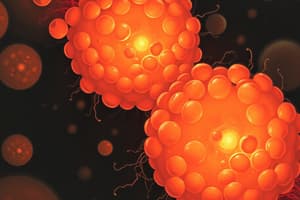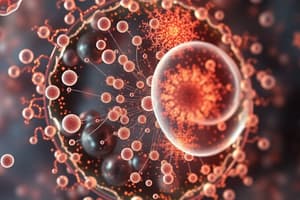Podcast
Questions and Answers
What are the predominant cells involved in phagocytosis?
What are the predominant cells involved in phagocytosis?
Macrophages are the predominant cells involved in phagocytosis.
Describe the role of receptor proteins in receptor-mediated endocytosis.
Describe the role of receptor proteins in receptor-mediated endocytosis.
Receptor proteins bind to specific ligands, which triggers the inward folding of the membrane to form vesicles.
What is an example of a process facilitated by clathrin-mediated endocytosis?
What is an example of a process facilitated by clathrin-mediated endocytosis?
Iron-bound transferrin recycling is an example of a process facilitated by clathrin-mediated endocytosis.
What type of transport is used for the uptake of large solids, such as starch?
What type of transport is used for the uptake of large solids, such as starch?
What distinguishes receptor-mediated endocytosis from general endocytosis?
What distinguishes receptor-mediated endocytosis from general endocytosis?
What role do growth factors play in the development of the ectoderm during organogenesis?
What role do growth factors play in the development of the ectoderm during organogenesis?
Describe the fate of the neural tube after its formation.
Describe the fate of the neural tube after its formation.
How does mesoderm differentiation contribute to vertebrate body structure?
How does mesoderm differentiation contribute to vertebrate body structure?
What is the primary function of the endoderm in organogenesis?
What is the primary function of the endoderm in organogenesis?
Explain how disruptions in growth factor signaling affect ectoderm differentiation.
Explain how disruptions in growth factor signaling affect ectoderm differentiation.
What structures arise from the somites formed in the mesoderm?
What structures arise from the somites formed in the mesoderm?
What is the significance of the notochord in embryonic development?
What is the significance of the notochord in embryonic development?
How does the endoderm change morphologically during organogenesis?
How does the endoderm change morphologically during organogenesis?
What is osmosis?
What is osmosis?
Define osmotic pressure.
Define osmotic pressure.
What happens to a cell during plasmolysis?
What happens to a cell during plasmolysis?
What role does turgor pressure play in plants?
What role does turgor pressure play in plants?
How do contractile vacuoles function in protists like paramecium?
How do contractile vacuoles function in protists like paramecium?
Differentiate between isotonic, hypertonic, and hypotonic solutions.
Differentiate between isotonic, hypertonic, and hypotonic solutions.
What adaptation do saltwater fish have to manage osmotic pressure?
What adaptation do saltwater fish have to manage osmotic pressure?
Explain the process of facilitated diffusion.
Explain the process of facilitated diffusion.
What happens to bcl-2 following cellular stress and how does this relate to apoptosis?
What happens to bcl-2 following cellular stress and how does this relate to apoptosis?
Describe the role of cytochrome C in the apoptosis pathway.
Describe the role of cytochrome C in the apoptosis pathway.
What process involves the material being forced out of a cell in bulk and requires energy?
What process involves the material being forced out of a cell in bulk and requires energy?
Identify one example of materials released from cells via exocytosis.
Identify one example of materials released from cells via exocytosis.
How do caspases contribute to the morphological changes observed during apoptosis?
How do caspases contribute to the morphological changes observed during apoptosis?
Explain the formation of apoptotic bodies during apoptosis.
Explain the formation of apoptotic bodies during apoptosis.
What is the role of the sodium-potassium pump in cellular function?
What is the role of the sodium-potassium pump in cellular function?
What triggers autophagy in cells and what is its primary function?
What triggers autophagy in cells and what is its primary function?
How many sodium ions bind to the sodium-potassium pump during its activation?
How many sodium ions bind to the sodium-potassium pump during its activation?
Discuss the difference between apoptosis and necrosis in terms of inflammatory responses.
Discuss the difference between apoptosis and necrosis in terms of inflammatory responses.
What occurs to ATP during the activation of the sodium-potassium pump?
What occurs to ATP during the activation of the sodium-potassium pump?
What change in the sodium-potassium pump occurs after the phosphorylation of aspartate?
What change in the sodium-potassium pump occurs after the phosphorylation of aspartate?
What is the role of PARP in the apoptosis pathway?
What is the role of PARP in the apoptosis pathway?
How does autophagy relate to cellular stress responses?
How does autophagy relate to cellular stress responses?
Which Nobel Prize was awarded in 1997 related to the sodium-potassium pump, and to whom?
Which Nobel Prize was awarded in 1997 related to the sodium-potassium pump, and to whom?
What is one of the primary functions of co-transporters in cellular transport?
What is one of the primary functions of co-transporters in cellular transport?
What is the significance of the deletion of the elastin gene in individuals with Williams syndrome?
What is the significance of the deletion of the elastin gene in individuals with Williams syndrome?
Describe the structure of laminin and its role in the extracellular matrix.
Describe the structure of laminin and its role in the extracellular matrix.
What role does fibronectin play in the extracellular matrix?
What role does fibronectin play in the extracellular matrix?
What distinguishes proteoglycans from glycoproteins?
What distinguishes proteoglycans from glycoproteins?
What are glycosaminoglycans (GAGs) and name at least three examples?
What are glycosaminoglycans (GAGs) and name at least three examples?
Explain the process of passive transport and list its three main types.
Explain the process of passive transport and list its three main types.
What is the primary energy requirement for active transport mechanisms in cellular transport?
What is the primary energy requirement for active transport mechanisms in cellular transport?
What is endocytosis and how does it relate to active transport?
What is endocytosis and how does it relate to active transport?
Flashcards
Organogenesis: Ectoderm
Organogenesis: Ectoderm
Ectoderm forms the nervous system (like brain & spinal cord) and the epidermis (skin).
Neural Plate Formation
Neural Plate Formation
Growth factors signal cells to become either skin or neural cells. Unsignalized cells form neural plate that folds into a tube (neural tube).
Neural Tube
Neural Tube
The tube formed from the neural plate, and develops into the brain and spinal cord.
Mesoderm differentiation
Mesoderm differentiation
Signup and view all the flashcards
Somites
Somites
Signup and view all the flashcards
Endoderm Function
Endoderm Function
Signup and view all the flashcards
Growth Factors
Growth Factors
Signup and view all the flashcards
Notochord
Notochord
Signup and view all the flashcards
Elastin
Elastin
Signup and view all the flashcards
Laminin
Laminin
Signup and view all the flashcards
Fibronectin
Fibronectin
Signup and view all the flashcards
Proteoglycan
Proteoglycan
Signup and view all the flashcards
Glycosaminoglycans (GAGs)
Glycosaminoglycans (GAGs)
Signup and view all the flashcards
Passive Transport
Passive Transport
Signup and view all the flashcards
Diffusion
Diffusion
Signup and view all the flashcards
Active Transport
Active Transport
Signup and view all the flashcards
Apoptosis Mechanism
Apoptosis Mechanism
Signup and view all the flashcards
Cytochrome C Release
Cytochrome C Release
Signup and view all the flashcards
Caspase Cascade
Caspase Cascade
Signup and view all the flashcards
Apoptosome Formation
Apoptosome Formation
Signup and view all the flashcards
Autophagy
Autophagy
Signup and view all the flashcards
Cellular Stress and bcl-2
Cellular Stress and bcl-2
Signup and view all the flashcards
Apoptosis Morphology
Apoptosis Morphology
Signup and view all the flashcards
Caspase Role in Apoptosis
Caspase Role in Apoptosis
Signup and view all the flashcards
Osmosis
Osmosis
Signup and view all the flashcards
Osmotic Pressure
Osmotic Pressure
Signup and view all the flashcards
Turgor Pressure
Turgor Pressure
Signup and view all the flashcards
Isotonic
Isotonic
Signup and view all the flashcards
Hypertonic
Hypertonic
Signup and view all the flashcards
Hypotonic
Hypotonic
Signup and view all the flashcards
Facilitated diffusion
Facilitated diffusion
Signup and view all the flashcards
Phagocytosis
Phagocytosis
Signup and view all the flashcards
Macrophages
Macrophages
Signup and view all the flashcards
Receptor-Mediated Endocytosis
Receptor-Mediated Endocytosis
Signup and view all the flashcards
Clathrin-Mediated Endocytosis (CME)
Clathrin-Mediated Endocytosis (CME)
Signup and view all the flashcards
LDL uptake
LDL uptake
Signup and view all the flashcards
Exocytosis
Exocytosis
Signup and view all the flashcards
What does exocytosis require?
What does exocytosis require?
Signup and view all the flashcards
P-type ATPase pump
P-type ATPase pump
Signup and view all the flashcards
Sodium-Potassium pump
Sodium-Potassium pump
Signup and view all the flashcards
Co-transporter
Co-transporter
Signup and view all the flashcards
Sodium-Glucose co-transporter
Sodium-Glucose co-transporter
Signup and view all the flashcards
Sodium-Calcium exchange
Sodium-Calcium exchange
Signup and view all the flashcards
What is a pump?
What is a pump?
Signup and view all the flashcards
Study Notes
Introduction to Embryonic Development
- A multicellular organism develops from a single cell (the zygote) into a collection of diverse cell types, organized into tissues and organs.
- Development involves cell division, body axis formation, tissue and organ development, and cell differentiation (acquiring a specific cell type identity).
- During development, cells use both intrinsic (inherited) information and extrinsic (neighboring cell signals) to determine their behavior and identity.
- Cells become progressively more restricted in their developmental potential (the kinds of cell types they can become) as development progresses.
Embryonic Stages
- Zygote (fertilized egg): a single-celled structure.
- 2-celled zygote: cleavage begins after fertilization.
- 4-celled zygote: further cell division.
- Morula: a solid mass of cells.
- Blastula: a hollow ball of cells with a fluid-filled cavity (blastocoel).
- Gastrula: a three-layered embryo with a developing gut (archenteron).
- Neurula: an embryo with a neural tube developing.
- Organogenesis: formation of organs from the respective germ layers.
Gametogenesis
- The process of forming gametes (sperm and ova).
- Undergoes meiosis, undergoing chromosomal and morphological changes to produce mature haploid gametes.
- Spermatogenesis (in testes): leads to sperm production.
- Oogenesis (in ovaries): leads to ovum production.
Common Terms
- Animal pole: the pole of the egg with the least yolk concentration.
- Animal hemisphere: the hemisphere of the egg containing the animal pole.
- Vegetal pole: the pole of the egg with the most yolk concentration.
- Vegetal hemisphere: the hemisphere of the egg containing the vegetal pole.
Fertilization
- The fusion of two gametes (sperm and ovum) to form a zygote.
- Involves several steps, including sperm-egg contact, sperm entry, and fusion of the nuclei.
- Results in combining of genes from both parents- creating a new organism.
Cleavage
- A series of rapid mitotic cell divisions of the zygote to form a multicellular structure (morula).
- Blastomeres are the cells produced during cleavage, becoming increasingly smaller with each division.
- The type and pattern of cleavage differentiate between species.
Blastulation
- The production of a multicellular blastula as a result of cleavage.
- Blastomeres (cells) within the blastula arrange to form a hollow ball (blastula) with a fluid-filled cavity (blastocoel).
Gastrulation
- Rearranges the blastula's cells, creating a three-layered (triploblastic) embryo called a gastrula.
- The gastrula features a primitive gut (archenteron), and cell movements (invagination, ingression).
Neurulation
- The formation of the neural tube in chordates (animals with a notochord).
- Ectodermal cells form a neural plate, which then sinks and forms a neural groove; the groove edges then fuse to create the neural tube.
- The anterior end of the neural tube becomes the brain and the posterior end becomes the spinal cord.
Organogenesis
- The formation of organs from the three germ layers (ectoderm, endoderm, and mesoderm).
- The process involves differentiation of embryonic stem cells into more specialized cell types.
- Signaling cascades guide the differentiation process.
- Ectoderm, involved in nervous and epidermal systems
- Mesoderm, involved in circulatory, musculoskeletal, excretory, and reproductive systems
- Endoderm, involved in digestive and respiratory systems
Cell Injury
- Cells facing stress or injury may undergo changes, classified as reversible or irreversible cell injury (death).
- Causes include oxygen deprivation, physical agents, chemical agents, infections, immunologic reactions, genetic defects, and nutritional imbalances.
- Important targets for injury include aerobic respiration, cell membranes, protein synthesis, cytoskeleton, and the genetic apparatus.
Cell Death
- Necrosis: tissue death by enzymatic digestion of damaged cells, involving inflammation.
- Apoptosis: programmed cell death that occurs during development and in response to certain signals, causing no inflammation.
Apoptosis
- A programmed form of cell death characterized by morphological changes.
- Involved in development, removal of damaged cells, and maintaining a healthy cell population.
- Regulated by a cascade of molecular events (e.g., caspase activation).
Autophagy
- A regulated process for removing damaged proteins and organelles within cells under certain conditions (e.g., starvation).
- Involves the formation of autophagosomes, which then fuse with lysosomes for degradation.
Homeotic Genes (Hox Genes)
- Master regulator genes that control the development of body segments or structures.
- Mutations in Hox genes can significantly alter body plan development.
- Crucial role in specifying the identity of different body regions.
Metamorphosis
- A transformation in the body form and characteristics of organisms during their development.
- Complete metamorphosis: egg -> larva -> pupa -> adult (e.g., butterfly).
- Incomplete metamorphosis: egg -> nymph -> adult (gradual changes, e.g., grasshopper).
Cell Signaling
- Cells communicate via chemical signals (ligands).
- Signaling involves ligand binding to receptors initiating a chain of events inside the target cell(signal relay pathways).
- Different pathways involving phosphorylation or second messengers relay signals.
- Types of signaling include paracrine, autocrine, endocrine, and juxtacrine.
Membrane Proteins
- Integral proteins span the membrane with hydrophobic regions and often coiled within.
- Plays roles in transportation (channels and pumps), receptors for signal reception, and enzymes localized at the membrane.
- Additional roles include cell-cell recognition and linking to the cytoskeleton.
Cell Junctions
- Structures that connect cells providing contact, adherence, interactions, and communication, both in plants (plasmodesmata) and animals (tight junctions, desmosomes, and gap junctions).
- Cell walls and ECM play supporting roles.
Plasma Membrane
- A selectively permeable boundary separating the internal and external environments of a cell.
- Composed of a phospholipid bilayer with hydrophobic tails and hydrophilic heads.
- Also includes proteins and carbohydrates.
- Fluid nature allows flexibility in the membrane.
ECM (Extracellular Matrix)
- Extracellular structural components found outside the cell membrane.
- In animals, it's made up of proteins like collagen, elastin, and fibronectin along with proteoglycans (large molecules with specific carbohydrates and proteins)
- Provide mechanical support to cells, help with cell adhesion and migration processes, and play a signaling role.
Transport Across Membranes
- Simple diffusion: movement of substances down their concentration gradient- passive, no energy required
- Facilitated diffusion: passive movement of substances through specific membrane proteins, no energy required.
- Active transport: movement of substances against their concentration gradient, requiring energy (ATP).
Studying That Suits You
Use AI to generate personalized quizzes and flashcards to suit your learning preferences.
Related Documents
Description
This quiz covers key concepts in cell biology and organogenesis, focusing on processes such as phagocytosis, endocytosis, and the roles of different cell types in embryonic development. Participants will explore the significance of growth factors and the distinctions between various cellular mechanisms. Additionally, the quiz addresses morphological changes during organogenesis.




